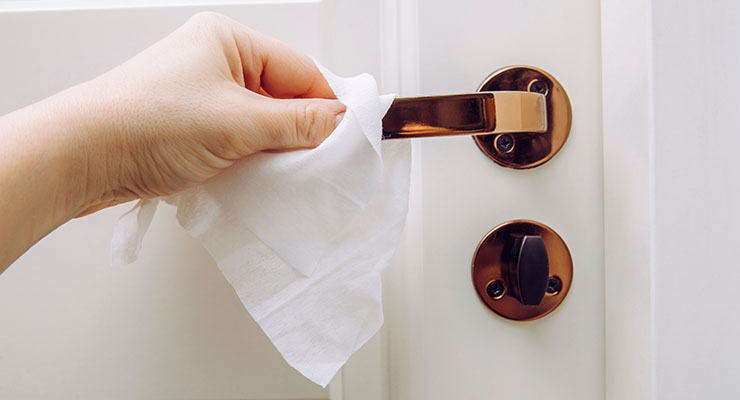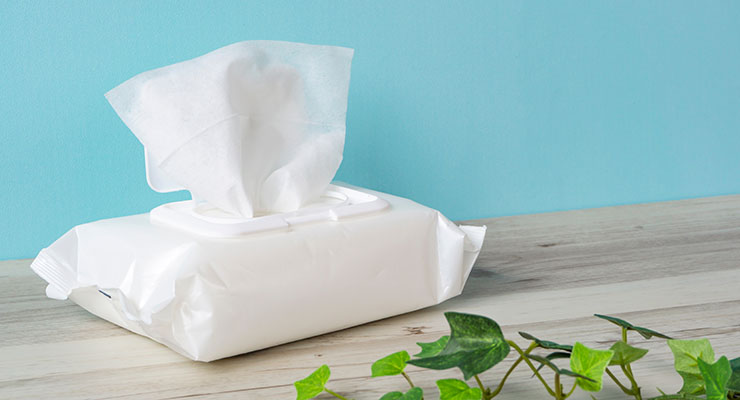As demand normalizes and capacity continues to ramp up, manufacturers of spunlaced nonwovens have reported challenging conditions, which have been further exacerbated by macroeconomic conditions like global inflation, rising raw material prices, supply chain issues and regulations limiting the use of single-use plastics in some markets.
In its most recent earnings call, Glatfelter Corporation, a nonwovens producer which diversified into spunlace manufacturing through the acquisition of Jacob Holm Industries in 2021, reported that both sales and earnings in the segment were lower than expected.
“Overall, the work ahead of us in spunlace is more than was originally anticipated,” Thomas Fahnemann, CEO, says. “The segment’s performance to date, along with the impairment charge we have taken on this asset is a clear indication that this acquisition is not what the company first thought it could be.”
Fahnemann, who assumed the top role at Glatfelter, the world’s largest airlaid producer, after the Jacob Holm purchase in 2022, told investors that spunlace continues to be considered a good fit for the company as the acquisition not only gave the company access to a strong brand name in Sontara, it provided it with new manufacturing platforms that complement airlaid and composite fibers. Returning spunlace to profitability was earmarked as one of the company’s six key areas of focus in its turnaround program.
“I believe the team has a good understanding of what is needed to stabilize the spunlace business to return to profitability,” Fahnemann adds. “We will address the cost base and optimize output so we can meet customer demand.”
The Jacob Holm acquisition includes assets in North Carolina, France and Germany.
Lynda Kelly, senior vice president, Americas and business development, of Suominen also indicated that profitability has been challenged, not just in spunlace but in nonwovens in general.
“Making a profit in the nonwovens market is difficult given the current market conditions of high raw materials, increasing energy costs and fluctuating labor conditions,” she says. “We are also seeing the increase of nonwovens competition from Asia and other parts of the world.”
Specific to wipes, in late 2020 and early 2021, many major customers, particularly in North America, had stockpiled materials during the pandemic and they stopped buying overnight, while more recently demand has fluctuated dependent on the market, according to Kelly. “With all of the challenges and changes in the market, we have had to really depend on fast reaction times, which is not a cost effective way to run a business because there tend to be lags when it comes to raw material costs and shipping fees,” she adds.
For its part, Suominen has remained conservative when it comes to investments, even during the high times of Covid-19. Rather than investing in new lines, the company has focused on improvement projects on existing lines in Nakkila, Finland, Cressa, Italy, and Bethune, SC, all with an eye toward nonwovens innovation and sustainability.
“Manufacturing sustainable nonwovens competitively requires production assets and processes optimized for these products,” Kelly adds. “These investments have positioned us well to support our strategic visions.”
Similarly, Suominen is looking to shutter assets that cannot be improved or upgraded to be inline with its sustainability strategy. In late December, the company said it was beginning consultations with local trade unions regarding a plan to cease manufacturing in Mozzate, Italy, where it houses two existing lines able to process only traditional blended fiber products.
“The demand for traditional blended fiber products in Europe is declining,” says interim CEO and president Klaus Korhonen. “Manufacturing sustainable nonwovens competitively requires production assets and processes optimized specifically for these products. Our lines at the Mozzate plant are not best suited for sustainable fibers, and this combined with high operating costs means that the plant is not competitive and its competitiveness is not expected to improve materially going forward. We are constantly evaluating the performance and profitability of our assets, and in the current situation we have unfortunately come to the conclusion that we need to consider closing the production at Mozzate to improve the competitiveness of our European business.”
Texol-Orma focuses on premium segments to protect marginality within its spunlace business. “The commodity segment (i.e. wet wipes) is under tremendous cost control and offering very low marginality,” Leonardo DiGuiseppe, sales and marketing, says. “The demand is increasing but, in most of the cases, the premium applications are still niche and therefore with limited volume with short production campaign.”
Like much of the spunlace market, Texol-Orma has invested significantly in sustainability, especially for the delivery of natural substrates like cotton and more recently hemp. Converting these natural fibers requires a specific carding wire that is creating some challenges for roll goods manufacturers who still have a mixed material portfolio.
Climbing Capacity
According to David Price, principal of industry consultancy Price Hanna, factors driving increased capacity vary by region. “Clearly demand for nonwoven spunlaced wiping substrates ebbed throughout the world since its peak in early 2021,” he says. “Some of the capacity ordered during that peak was not commissioned until 2022 while some capacity planned for installation in 2023 was halted given weakening demand.”
In the past 24 months, capacity expansions have largely centered around developing areas like China and Turkey but even western-based companies have sought to capitalize on wipes market growth. Berry Global has recently completed work on a spunlace line in Cuijk, the Netherlands, which is allowing it to develop sustainably-based materials for wipes and other applications. Recognizing its customers’ ongoing environmental sustainability goals, the new asset incorporates the production of biodegradable or recycled nonwoven substrates, increasing Berry’s capacity in Europe by more than 300 million square meters.“This multimillion-dollar investment further completes our industry-leading portfolio. Through flexible assets such as this installation in Europe, we can better serve our customers with reliable, sustainable solutions for the wipes market,” says Achim Schalk, EVP and general manager, EMEIA for Berry’s Health, Hygiene, and Specialties Division.
Berry had also planned to add a wipes-related asset, featuring its proprietary Spinlace capacity, in North America, but later cancelled that investment due to changing market conditions. Meanwhile, another North American investment, Fibertex Nonwovens’ second spunlace line at its facility in South Carolina has come onstream and is serving the wipes market.
Meanwhile, China continues to await new spunlace investment including one by Xingjian Zhongtai Nonwovens, which started its first line in June 2022 and plans to eventually operate 12 lines, totaling 140,000 tons capacity. Additionally Zhoukou Xingwang is in the process of adding two spunlace lines.
These are just a few examples of ambitious spunlace investment from Chinese companies that are not only responding to heightened demand but also looking at modern technology offering higher productivity and the ability to use sustainable raw materials.
“China has by far seen the highest rate of new capacity installations for spunlace,” Price says. “Both new and existing spunlace producers have responded to strong demand for wipes as the Covid pandemic surged and spiked in the country. These products are also adding modern capacity to take advantage of technology advancements in productivity and adaptability for sustainable raw materials to improve the region’s competitive in the global market.”
Meanwhile, in India, Welspun has recently completed construction on neXline spunlace line capable of processing a variety of fibers from Andritz for the production of nonwoven roll goods and wipes for its new plant in Hyderabad, Telangana, India. The line has a capacity of up to three tons per hour.
This line is allowing Welspun to process various types of synthetic or natural fibers, such as polyester, viscose and cotton. The final products will have fabric weights ranging from 25 to 120 gsm, thus covering many applications. This neXline spunlace line also offers the option to integrate a third component from a selection of smart layers, to enable Welspun to manufacture products for the healthcare and hygiene sectors.
Elsewhere in India, industry newcomer Tufropes, a global leader for ropes and netting, added a spunlace line Gujarat, India early last year. Proprietary refinements, which were developed with partners Truetzschler and Voith, will allow Tufropes to produce any possible hydroentangled nonwoven material, including biodegradable, natural fiber eco-friendly high-performance nonwovens.
According to Arnaud Laroche, head of sales, Spunlace, Andritz Perfojet, new line investment is a way that companies are able to increase their profitability both by capitalizing on synergies with existing lines and also by taking advantage of more efficient modern processing speeds.
“Some of the nonwovens players have decided to increase their capacity (to increase profitability),” he says. “This enables them to reduce costs in euro per kilogram. Thanks to its long-term know-how Andritz Nonwovens offers compact layouts of complete spunlace lines which allow our customers to build smaller plants, reduce global footprint, emissions and utility requirements.”
Wipes Innovation Focuses on Sustainability
According to Phil Mango, the author of the Smithers report, The Future of Spunlace Nonwovens through 2026, the largest end use for spunlace nonwovens by far is wipes and the pandemic-related surge in disinfecting wipes even increased this. In 2021, wipes accounted for 64.7% of all spunlace consumption in tons. The global drive to reduce/eliminate plastics in wipes has spawned several new spunlace variants by 2021; this will continue to keep spunlace the dominant nonwoven for wipes through 2026. By 2026, wipes will grow its share of spunlace nonwovens consumption to 65.6%.One of the most significant drivers of the last decade is the need to reduce/eliminate plastics in wipes and other nonwoven products, he adds. While the European Union’s single use plastics directive was the catalyst, the reduction of plastics in nonwovens has become a global driver and especially for spunlace nonwovens.
Beyond government regulations, consumer preference and retailer mandates are also making wipes manufacturers—and by extension their spunlace suppliers—reexamine their raw material usage. Already several U.K.-based retailers have banned the sale of plastic-based wipes in their stores and having their suppliers reformulates their store brand products to remove plastic.
According to Marco Fano, CMO of equipment supplier Autefa Solutions, the demand for sustainable nonwovens is clear and a leading topic in most discussions with customers in all fields of spunlaced nonwovens from wipes to geotextiles and clothing. This is being driven by recent technolgies’ ability to be made with up to 30% less energy consumption, compared to existing traditional spunlace technologies. This is opening up new markets, even in high fashion products like artificial leather based on natural leather waste and other sustainable products, Fano adds.
A global market leader of spunlaced nonwovens and other wipe substrates, Suominen has taken a lead when it comes to sustainability. “Sustainability is of growing importance to our customers and other stakeholders,” says senior vice president Lynda Kelly. “We help our customers to achieve their own environmental targets by offering them products made from e.g. renewable, recycled, compostable and plastic-free raw materials.”
These new product entries included Biolace Pure, a 100% plant-based product with superior cleaning power, Biolace Bamboo, a bamboo-based substrate. Both of these products provide clear advantages in terms of reducing the CO2 footprint and a lower environmental impact.
As part of a sustainability-focused business strategy introduced last year, Suominen has a goal of increasing sales of sustainable products by 50% by 2025 and to have more than 10 sustainable product launches per year.
Sandler recognizes the growing importance of sustainability to end consumers and therefore to manufacturers, says Ulrich Hornfeck, CCO, Sandler. “The sustainability of our products as well as possible implications of their use to consumers or the environment are taken into account from the initial development stage onwards,” he says. “Already, today Sandler uses about 30% renewable and recycled raw materials, among them raw materials from renewable sources, such as viscose, cotton or the lactic-acid based polymer PLA for spunlaced nonwovens. The spunlace technology offers the possibility to adapt the nonwovens’ raw material composition while maintaining established products functionality and quality.”
The Texol-Orma group has invested significantly in sustainability, especially for the delivery of natural substrates, according to DiGuiseppe. “Cotton, hemp and more recently flax too—the converting of natural fibers requires a specific carding wires and this is creating some challenges for all roll goods manufacturers that have still a mixed material portfolio, meaning using natural fibers but still keeping synthetic fibers in the mix.”
Technological developments like its line configured with two cards and an airlaid head have allowed it Orma-Texol to create a cross lapped web that is applied in a plastic-free absorbent core for applications in feminine care products.
“In this case we have been able to design an absorbent core, 100% based on artificial fibers combined with cellulose pulp,” DiGuiseppe adds. “This is just the first step as we have development to use bast fibre instead of viscose and using “tree-free” cellulose from other sources like hemp or cotton. This is how we want to differentiate in the sustainable arena.”
These new developments in sustainable manufacturing are being aided by the work of machinery and equipment suppliers who recognize that sustainability has become a crucial concern of the nonwovens industry.
“We have developed a new strategy to reduce plastic content and introduce renewable and natural raw materials,” says Laroche. “Andritz is pushing forward in the development of innovative technologies like spunlace and Wetlace, for the production of sustainable wet wipes. All these processes are using hydroentanglement which is the most efficient solution to bind a large array of fibers without using any thermofusion or chemical binders.”
Mogul, which offers a diversified spunlace product lineup, has been making nonwovens with bamboo fibers, a cellulosic material that is regenerated from the bamboo plant. Additionally, the company can make materials from 100% bio-based polyester or blended products which have been specifically designed to biodegrade in the environments where the vast majority of plastic often end up—landfills and oceans.
“Biobased sustainable spunlace materials are getting more important day by day due to the latest European regulations published by the European Union,” says commercial director Serkan Gogus. “Additionally, we observed the people care more about environmentally friendly products in the world due to climate change and environmental pollution and they turn their face to more biofriendly materials.”
Not Just Wipes
Outside of its standard spunlace offerings, Mogul currently offers both parallel and crosslapped spunlace technology as well as unique bico-pet technology marketed under the Madaline brand name. Having this diverse range of product has shielded the company from being too reliant on wipes applications.
“We see a decline with demand on the wipes side, especially disinfectant wipes which boomed during the pandemic but has still remained higher than it was pre-pandemic,” says Gogus. “We are also observing growth in demand of industrial end uses such as automotive but the capacity has been growing much more quickly than demand and there’s overcapacity which will take time to absorb.”Mogul’s Metatex high performance spunlace range provides a range of high grade fabrics that answer the market’s need for a lightweight materials for thermal clothing like firefighter gear and as rubber reinforcements.
“From protective clothing to automotive hoses and filtration systems, the possibilities are very wide ranging,” Gogus adds. “It provides a longer lifetime for automotive hoses, industrial felts, filtration bags and products for severe heat conditions.”
Norafin’s spunlace technology also lends itself to higher performance applications thanks to a turbo card system incorporating “air knives” into the carding system to essentially blow up the fibers after the initial carding step and is laid down on the line in a randomized form. The materials made on these lines are well suited to performance driven areas like filtration and high temperature applications. Within wipes, Norafin has chosen to focus beyond wet wipes and baby wipes to more high performance categories.
“Spunlace materials offer a number of advantages, mainly the dimensional stability and even basis weight distribution that we see from our carding system,” Will Matthews, senior sales manager, says. “While we may not produce materials for the wet wipes/baby wipes markets, we are producing a number of value added materials for a number of wiping markets. This is largely due to our flexible production capability and this flexibility allows us to process colored fibers in our systems.
“We continue to work on further developments in a number of high performance markets,” adds Matthews. “While our expertise comes from all we have done with aramid fibers for our thermal liner applications, we are now looking at several new applications. For example, we have begun to work on different cut resistant materials as well as working with oxidized fibers for fire blocking applications in eating.”
Other areas of interest are oxidized fibers as alternative blend options for a filtration applications as well as the development of biodegradable hemp fibers, which could be ideal for wipes and cosmetics applications.
Sandler also focuses on a diverse range of markets beyond wipes and hygiene for its spunlace business, which has allowed it to succeed despite vigorous competition worldwide.
“In a market as dynamic and versatile as nonwovens, growth is driven by product differentiation and new developments,” Hornfeck says. “The combination of spunlaced nonwovens with other material creates new material profiles and opens new applications. The growing importance of sustainability also brings about a high level of innovation as manufacturers search for new raw materials or combinations to offer greener products.”





